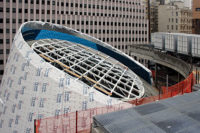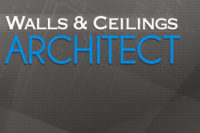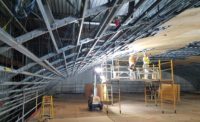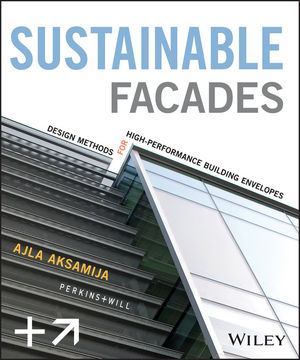It’s a wrap. Work on a giant metal “ribbon” that twists and turns around the new air traffic control tower at the Edmonton International Airport in Canada is now complete.
Designed by DIALOG, a Canadian-based architectural firm, the control tower is situated on top of the outer edge of a 10,000 square meter office building, called the Combined Office Tower. The control tower façade features a metal “wrap,” which is covered with shingled undulating zinc, and carefully integrated with the windows to maximize daylight and offer shading when needed. Each section was sculpted to meet rigorous viewing requirements set forth by Nav Canada for air traffic controllers watching the tarmac, runways and skies.
Architect Stephen Boyd says the architectural team took its cue from the tall prairie grasses which surround the airport, which are sculpted by the westward-blowing winds in summer, and are in motion by windborne snowdrifts in winter.
Radius Track worked with Thermal Systems KWC Ltd., the building envelope contractor, and Gehry Technologies, parametric modeling experts, to design and build the asymmetrical metal ribbon.
“This project represented one of our most significant design achievements to date,” says Bob Krebsbach, president of Radius Track. “The architect’s vision was stunning, but it took some innovative thinking and teamwork to bring the irregular wrap of the metal to precise execution.”
DESIGN TEAM IMPROVES CONSTRUCTABILITY
The fabrication challenge was to find a way to make the metal curves smooth, while accommodating the undulating design of the wrap. When Gehry Technologies joined the project team, they decided to use site surveys instead of the original construction documents to define the exact location of each truss that would support the metal ribbon. Working with Radius Track, they developed a simple solution—a method for curving hat channel—that provided a smooth attachment surface for the finishing materials.
“With these types of projects, there are subtle differences in form, so geometry makes all the difference—our job was to find a way to improve the constructability of the project,” says Gehry Technology’s senior project consultant Jason Sidelko. “Coming in mid-project, we had to find a system that would work with the existing steel and glazing systems that were already in play.”
Thermal Systems had originally explored using curved pipe to control the geometry of the ribbons and to provide an attachment point for the steel decking and zinc panels, which make up the ribbon surface. But creative thinking by the three companies provided another solution that worked extremely well and helped produce the tower’s graceful curves. The team found a way to provide an extremely smooth surface by using the hat channel system, which ultimately reflected the dramatic statement created by the twisting ribbons.
The scope of the project was significant. The wrap begins 43 feet above the ground and twists upward to its overall height of 148 feet. Each metal ribbon contains either three or two facets that vary in height, width, thickness, and angle as they trace around the building, depending on the aesthetic and shading requirements.
Prior to fabrication, the manufacturer generated a 3-D model of the metal wrap. In the virtual computer based environment, hat channel and truss locations were set in digital space. During fabrication, Radius Track used this information to mark the centerline of each truss attachment location on the hat channel. The accuracy was so high that installation crews sometimes used the hat channels to place the location of the trusses, versus the other way around.
Tyler Weisgerber, Commercial Division Manager at Thermal System says, “The materials used were significantly more efficient and allowed for a faster and less complicated installation with a higher quality result.”
Already extremely tight deadlines were suddenly accelerated mid-project. In response, Thermal Systems took advantage of GT’s extraordinary ability to process large volumes of complex data and Radius Track’s ability to quickly fabricate the hat channel to exact detail.
“We developed an intricate system of communication that maximized the efficiency of each of the three companies,” says Krebsbach. “BIM technology streamlined everything and made it possible to accelerate the timeframes.”
ADVANCE PLANNING EASES INSTALLATION CHALLENGES
Construction was done “air-side” at the airport, which meant some unusual challenges for the design team, who had to work in close proximity to the planes and associated dust and debris that accompanies take-off and landing. Trish Griep, Thermal Systems’ architectural cladding and roofing manager, notes, “Deliveries, installation schedules, many other details had to be meticulously coordinated. There wasn’t much space to work with, and planes taking off and landing all day added to the challenge. Our installation team truly rose to the occasion.”
Another critical detail involved coding and organizing the hat channel in such a way that it could be quickly staged and assembled onsite. To accomplish this, Thermal Systems and Radius Track developed a nomenclature to help identify material at the job site, which included a special labeling system to match up the hat channel with the trusses.
Prior to shipment, all material was meticulously sequenced and packaged. Upon arrival, Thermal Systems needed only to match up the numbers and colors. Another challenge was the height of the structure; the top level is 12 stories off the ground. Specialty mast-climbing platforms were installed to provide Thermal Systems’ access to the building exterior, but the staging area on site was extremely tight as it was air-side. Using feedback from the Thermal Systems’ installation team, Radius Track took this into consideration and shipped everything in scaffolding-sized packaging to help ease the installation.
When the new tower opens at the beginning of 2013, it will stand as an icon- the first and last significant building seen by travelers visiting the Edmonton International Airport. The free-flowing twists and turns of the building will be enjoyed from the terminal and nearby roads. As part of Canada’s fastest growing airport, the Edmonton tower adds an impressionable design statement that will be appreciated by the six million people who travel through its gates each year. W&C












Report Abusive Comment